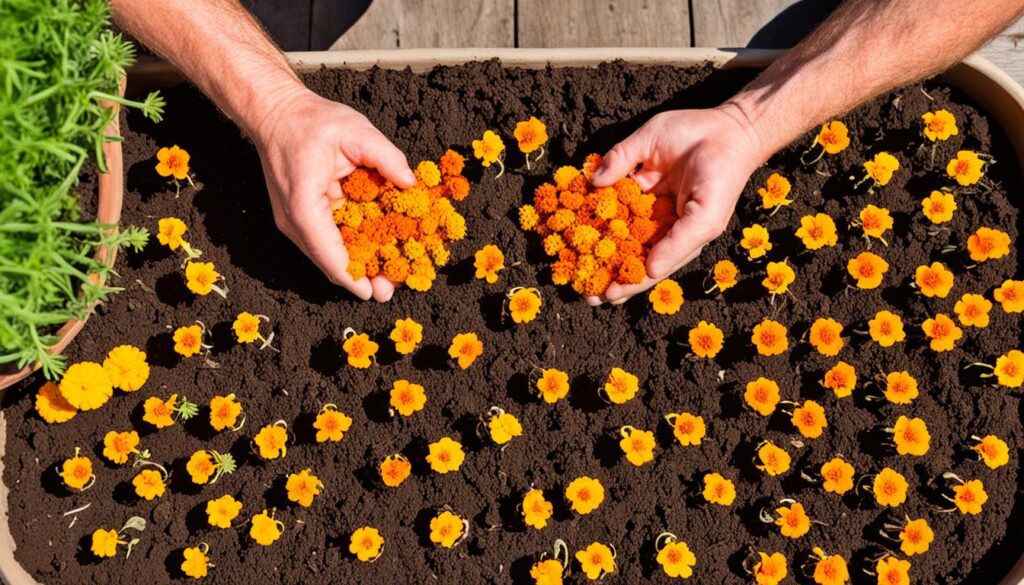Marigolds, with their vibrant colors and cheerful blooms, are a favorite choice for many gardeners. But have you ever wondered if these popular annual flowers have any specific soil preferences? In particular, do marigolds like acidic soil? Let’s explore this question and unravel the secrets to nurturing marigolds to perfection.
Key Takeaways:
- Marigolds prefer slightly acidic to neutral soil, with a pH range of 6.0 to 7.0.
- They are low-maintenance plants that require full sun and well-drained soil.
- Deadheading marigolds can promote continuous blooming throughout the summer.
- Understanding the cultural significance of marigolds adds to the appreciation of these versatile and beloved flowers.
- By providing the right growing conditions and care, you can nurture marigolds to vibrant and healthy blooms in your own garden.
The Types of Marigolds and Their Growing Conditions
Marigolds are a diverse group of flowers that come in various types, each with its own unique characteristics and growing conditions. Understanding the different types of marigolds and their specific requirements can help you cultivate these vibrant blooms successfully.
African Marigolds
African marigolds (Tagetes erecta) are known for their large, showy flowers that resemble pom-poms. These marigolds can reach impressive heights of up to 4 feet, making them the perfect choice for adding vertical interest to your garden. They come in a range of colors, including yellow, orange, and burgundy.
French Marigolds
French marigolds (Tagetes patula) are compact and bushy plants that typically reach a height of about 1 foot. These versatile marigolds are available in a wide array of vibrant colors, such as red, orange, and bi-color combinations. French marigolds are excellent for edging borders, filling containers, and attracting beneficial insects to your garden.
Signet Marigolds
Signet marigolds (Tagetes tenuifolia) feature lacy leaves and produce charming single flowers. These marigolds are perfect for adding a delicate touch to your landscape or containers. They are available in shades of yellow and orange and release a pleasant fragrance when touched or brushed against.
Growing Conditions for Marigolds
Regardless of the type, marigolds have similar growing requirements. They thrive in full sun, preferring at least six hours of direct sunlight per day. Make sure to plant them in well-drained soil that is slightly acidic to neutral, with a pH range of 6.0 to 7.0. Marigolds are relatively drought-tolerant once established, but consistent watering is essential during dry periods.
Comparison of Marigold Types
| Marigold Type | Height | Flower Size | Colors | Fragrance |
|---|---|---|---|---|
| African Marigolds | Up to 4 feet | Large | Yellow, Orange, Burgundy | No |
| French Marigolds | Around 1 foot | Medium | Red, Orange, Bi-color | No |
| Signet Marigolds | Around 1 foot | Small | Yellow, Orange | Yes |
Each type of marigold brings its own unique aesthetic appeal to your garden. Consider your desired height, flower size, color palette, and fragrance preferences when selecting the right marigolds for your outdoor space.
Now that you are familiar with the different types of marigolds and their growing conditions, you can confidently choose the perfect marigolds for your garden and provide them with the optimal environment to thrive.
Planting Marigolds from Seeds
If you’re looking to add vibrant and resilient marigolds to your garden, planting them from seeds is an easy and rewarding option. By following a few simple steps, you can watch these beautiful flowers bloom and thrive in your own backyard.
To begin, start by selecting high-quality marigold seeds from a reputable source. Ensuring the quality of the seeds is crucial for successful germination and healthy growth. Once you have your seeds, it’s time to prepare the soil.
Loosen the soil by removing any weeds and breaking up any clumps. Marigolds prefer well-drained soil, so ensure that the soil is loose and crumbly. This will provide a suitable environment for the seeds to establish their roots.
Next, sow the marigold seeds directly into the soil according to the spacing instructions provided on the packet. Make sure to follow these instructions carefully to give the seedlings enough room to grow. Gently press the seeds into the soil, ensuring they make good contact with the earth.
Cover the seeds with a thin layer of soil. This will protect them and provide the necessary darkness for germination. Be careful not to bury the seeds too deep, as they require light to trigger germination.
Now, it’s time to wait for the magic to happen. Keep the soil consistently moist but not overly saturated. Water gently, avoiding excessive force that may dislodge the seeds or young seedlings.
Once the seedlings emerge, it’s important to thin them out. This involves removing some of the seedlings to provide adequate spacing for the remaining plants. This step ensures that each marigold has enough room to grow and flourish.
When the seedlings have developed their first true leaves, they can be transplanted into larger containers or directly into your garden bed. Take care to handle the delicate seedlings with care, gently loosening their roots from the soil before replanting them.
| Planting Marigolds from Seeds: Steps at a Glance |
|---|
| Select high-quality marigold seeds from a reputable source. |
| Prepare the soil by removing weeds and loosening it. |
| Sow the seeds directly into the soil following spacing instructions. |
| Press the seeds gently into the soil and cover with a thin layer of soil. |
| Keep the soil consistently moist, avoiding overwatering. |
| Thin out the seedlings to provide adequate spacing. |
| Transplant the seedlings into larger containers or the garden bed when they have developed their first true leaves. |
Caring for Marigolds: Light, Watering, and Fertilizing
Proper care is essential for the health and vitality of your marigolds. By providing them with the right amount of light, watering, and fertilizing, you can ensure their robust growth and vibrant blooms.
Light Requirements
Marigolds thrive in full sun, requiring at least 6 hours of direct sunlight each day. They are sun-loving plants that revel in the warmth and light. Although they can tolerate some shade, planting them in a sunny spot will result in more abundant and colorful flowers. So be sure to find a location in your garden where they can bask in the sunshine and flourish.
Watering
One of the keys to caring for marigolds is providing adequate water. These plants prefer consistently moist soil. However, it’s important not to overwater them, as this can lead to root rot. Aim to keep the soil evenly moist, but not soggy. As the plants establish their root systems, they become more drought-tolerant. Nevertheless, it’s still beneficial to water them regularly, especially during dry spells, to promote healthy growth and blooming.
Fertilizing
Marigolds are not heavy feeders and generally don’t require much fertilizer. However, if your soil is extremely poor or you want to enhance their growth, you can provide a boost with organic or slow-release fertilizers. Choose a balanced fertilizer with a ratio of equal parts nitrogen, phosphorus, and potassium (N-P-K), such as 10-10-10 or 14-14-14, and follow the package instructions for application rates. Applying fertilizer sparingly every 4-6 weeks will help provide the necessary nutrients for robust foliage and abundant flowers.
| Caring for Marigolds: Light, Watering, and Fertilizing | Summary |
|---|---|
| Light Requirements | Marigolds thrive in full sun and should receive at least 6 hours of direct sunlight each day. While they can tolerate shade, they will produce fewer flowers in shady conditions. |
| Watering | Keep the soil consistently moist, but avoid overwatering. Water regularly, especially during dry periods, to ensure healthy growth and blooming. |
| Fertilizing | Marigolds are not heavy feeders and generally don’t require much fertilizer. However, if the soil is poor or you want to enhance growth, apply a balanced fertilizer sparingly every 4-6 weeks. |
Common Pests and Diseases of Marigolds
While marigolds are generally resistant to pests and diseases, they can still fall prey to a few common issues. By being aware of these potential problems and taking proactive measures, you can ensure that your marigolds stay healthy and vibrant.
Pests
Marigolds can be affected by several common pests, including:
- Snails and slugs: These slimy creatures can munch on marigold leaves and leave behind unsightly damage. To keep them at bay, clear the area of leaf debris and create traps using beer or copper barriers.
- Aphids: These tiny insects can suck sap from marigold leaves, causing them to wilt. Use horticultural soaps or oils to control aphid infestations.
Diseases
Marigolds can also be susceptible to certain diseases, including:
- Powdery mildew: This fungal disease appears as a white, powdery coating on the leaves, stunting growth and reducing flower production. To prevent powdery mildew, provide good air circulation around the plants and water at the base, avoiding overhead watering.
Marigolds have natural pest-deterrent properties and rarely require pesticides. However, if the infestation or disease persists, you can consider using organic or chemical pesticides as a last resort.
| Pest or Disease | Symptoms | Prevention | Treatment |
|---|---|---|---|
| Snails and Slugs | Evidence of leaf damage and holes | Clear leaf debris and create traps | Use beer or copper barriers |
| Aphids | Wilting leaves and sticky residue | Use horticultural soaps or oils | Apply insecticidal soap or spray with water |
| Powdery Mildew | White powdery coating on leaves | Provide good air circulation and avoid overhead watering | Apply fungicidal treatments or remove infected foliage |
By keeping a watchful eye on your marigolds and promptly addressing any signs of pests or diseases, you can ensure that these vibrant flowers thrive in your garden.
Propagating Marigolds: Seeds and Stem Cuttings
If you want to expand your marigold collection, you’ll be pleased to know that propagating these vibrant flowers is a breeze. Marigolds can be easily grown from either seeds or stem cuttings. Let’s explore both methods and learn how to propagate marigolds successfully.
Propagating from Seeds
Starting marigolds from seeds allows you to experience the joy of watching the entire growth process. You can either start the seeds indoors or directly sow them into your garden soil. To get started, follow these simple steps:
- Select high-quality marigold seeds from a reputable source.
- Prepare the garden soil by loosening it and removing any weeds.
- Sow the seeds on the surface of the soil and gently press them down.
- Cover the seeds with a thin layer of vermiculite.
- Water the soil gently to keep it moist.
- When the seedlings have sprouted and developed new leaves, it’s time to thin them out. This allows each plant to have enough space to grow and thrive.
- Transplant the seedlings outdoors to larger containers or your garden bed once they are strong enough and have a good root system.
Propagating from Stem Cuttings
If you have established marigold plants, you can easily propagate new ones from stem cuttings. Follow these steps to successfully propagate marigolds from stem cuttings:
- Select a healthy stem from an established marigold plant.
- Cut a 4-6 inch section of the stem just below a leaf node using clean garden shears.
- Remove any lower leaves from the stem cutting.
- Fill a small pot or tray with a seed-starter mix or potting soil.
- Make a small hole in the soil with a pencil or your finger.
- Place the stem cutting in the hole and gently press the soil around it to secure it in place.
- Water the cutting gently, ensuring the soil is moist but not saturated.
- Place the pot or tray in a warm and well-lit area, away from direct sunlight.
- After a few weeks, the cutting should develop roots. You can gently tug on it to check if it has taken root.
- Once the cuttings have rooted, you can transplant them into larger pots or directly into your garden.

“Propagating marigolds from seeds or stem cuttings allows you to multiply these colorful beauties and share them with others. It’s a rewarding process that gives you a sense of accomplishment and adds more beauty to your garden.” – Gardening Enthusiast
The Symbolism of Marigolds in Aztec Culture and Day of the Dead
Marigolds have deep cultural and symbolic significance in Aztec culture. They were used in religious ceremonies, healing practices, and human sacrifice rituals. Marigolds played a prominent role in the Aztec capital of Tenochtitlán and were associated with the gods. Today, marigolds continue to hold significance during the Day of the Dead celebrations in Mexico and among Hispanic communities.
“Marigolds were not only a staple in Aztec rituals but also valued for their medicinal properties and believed to have protective powers.”
Marigolds are believed to guide the spirits of the deceased with their vibrant color and distinct scent during the Day of the Dead. This ancient tradition, rooted in Aztec culture, symbolizes the connection between the living and the dead. By decorating altars and graves with marigolds, people honor and remember their loved ones, celebrating the cycle of life and remembering that it is transient.
According to Aztec belief, marigolds were considered sacred and could help guide souls through the afterlife. The bright orange and yellow hues of marigolds are thought to attract the spirits of the departed, leading them back to the world of the living for a brief reunion during the Day of the Dead.
During this time, marigolds are used to adorn altars, tombstones, and the pathways leading to cemeteries. Their vibrant colors and the sweet fragrance are believed to help the spirits find their way and provide comfort to the living. Marigolds are also used to create intricate floral arrangements, known as “cempasúchil,” which are an essential part of the Day of the Dead festivities.
Marigolds are not only beautiful flowers but also hold a profound cultural and symbolic significance. They represent the ephemeral nature of life and the belief that death is not the end but a continuation of the journey. The vibrant colors and delicate petals of marigolds serve as a reminder to cherish every moment and appreciate the connections we have with our loved ones.
The Symbolism of Marigolds in Aztec Culture:
| Symbolism | Meaning |
|---|---|
| Protection | Marigolds were believed to have protective powers and were used to ward off evil spirits. |
| Sacrifice | Marigolds were often used in rituals and human sacrifice ceremonies. |
| Healing | Marigolds were valued for their medicinal properties and used in various healing practices. |
The Symbolism of Marigolds in Day of the Dead:
- Guidance: Marigolds are believed to guide the spirits of the deceased back to the world of the living during the Day of the Dead.
- Connection: By using marigolds to decorate altars and graves, people symbolically connect with their departed loved ones.
- Celebration: Marigolds are an integral part of the vibrant and festive atmosphere of the Day of the Dead celebrations.
By understanding the symbolism of marigolds in Aztec culture and the Day of the Dead, we can gain a deeper appreciation for these beautiful flowers and the cultural traditions they represent.
Conclusion
Marigolds are truly remarkable flowers that can enhance the beauty of any garden. With their vibrant colors and sturdy nature, they add a touch of joy and vitality to your outdoor space. To grow marigolds successfully, it’s important to provide them with the right conditions, starting with slightly acidic to neutral soil. Aim for a pH range of 6.0 to 7.0 to ensure optimal growth and blooming.
Whether you choose to start marigolds from seeds or nursery starts, remember that they thrive in full sun. Find a sunny spot in your garden where these marvelous flowers can soak up at least 6 hours of direct sunlight every day. Additionally, you’ll want to maintain regular watering to keep the soil moist, but be careful not to overwater and let it become soggy.
As low-maintenance plants, marigolds don’t demand much from you in terms of care. However, deadheading the spent flowers can contribute to continuous blooming throughout the summer. By removing the faded blooms, you encourage the production of new buds, extending the flowering period and ensuring that your marigolds remain vibrant and beautiful.
Lastly, as you nurture your marigolds, take a moment to appreciate their cultural significance. Marigolds play an important role in Aztec culture and the Day of the Dead celebrations. Understanding the symbolism behind these flowers adds depth to your gardening experience and connects you to rich traditions.
So, armed with the knowledge of the ideal growing conditions and care tips, you can create a stunning garden filled with healthy marigold blooms. Enjoy the process of tending to these remarkable flowers, and let their radiant presence bring a burst of joy to your outdoor space.
FAQ
Do marigolds like acidic soil?
Yes, marigolds prefer slightly acidic to neutral soil with a pH range of 6.0 to 7.0.

